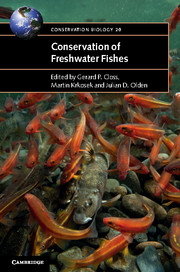Book contents
- Frontmatter
- Contents
- List of contributors
- Preface
- 1 Lost fishes, who is counting? The extent of the threat to freshwater fish biodiversity
- 2 Why are freshwater fish so threatened?
- 3 Climate change effects on freshwater fishes, conservation and management
- 4 Challenges and opportunities for fish conservation in dam-impacted waters
- 5 Chemical pollution
- 6 Multiple stressor effects on freshwater fish: a review and meta-analysis
- 7 Infectious disease and the conservation of freshwater fish
- 8 Non-indigenous fishes and their role in freshwater fish imperilment
- 9 Riparian management and the conservation of stream ecosystems and fishes
- 10 Fragmentation, connectivity and fish species persistence in freshwater ecosystems
- 11 Conservation of migratory fishes in freshwater ecosystems
- 12 Protecting apex predators
- 13 Artificial propagation of freshwater fishes: benefits and risks to recipient ecosystems from stocking, translocation and re-introduction
- 14 Freshwater conservation planning
- 15 Sustainable inland fisheries – perspectives from the recreational, commercial and subsistence sectors from around the globe
- 16 Understanding and conserving genetic diversity in a world dominated by alien introductions and native transfers: the case study of primary and peripheral freshwater fishes in southern Europe
- 17 Maintaining taxonomic skills; the decline of taxonomy – a threat to fish conservation
- 18 Synthesis – what is the future of freshwater fishes?
- Index
- References
18 - Synthesis – what is the future of freshwater fishes?
Published online by Cambridge University Press: 05 December 2015
- Frontmatter
- Contents
- List of contributors
- Preface
- 1 Lost fishes, who is counting? The extent of the threat to freshwater fish biodiversity
- 2 Why are freshwater fish so threatened?
- 3 Climate change effects on freshwater fishes, conservation and management
- 4 Challenges and opportunities for fish conservation in dam-impacted waters
- 5 Chemical pollution
- 6 Multiple stressor effects on freshwater fish: a review and meta-analysis
- 7 Infectious disease and the conservation of freshwater fish
- 8 Non-indigenous fishes and their role in freshwater fish imperilment
- 9 Riparian management and the conservation of stream ecosystems and fishes
- 10 Fragmentation, connectivity and fish species persistence in freshwater ecosystems
- 11 Conservation of migratory fishes in freshwater ecosystems
- 12 Protecting apex predators
- 13 Artificial propagation of freshwater fishes: benefits and risks to recipient ecosystems from stocking, translocation and re-introduction
- 14 Freshwater conservation planning
- 15 Sustainable inland fisheries – perspectives from the recreational, commercial and subsistence sectors from around the globe
- 16 Understanding and conserving genetic diversity in a world dominated by alien introductions and native transfers: the case study of primary and peripheral freshwater fishes in southern Europe
- 17 Maintaining taxonomic skills; the decline of taxonomy – a threat to fish conservation
- 18 Synthesis – what is the future of freshwater fishes?
- Index
- References
Summary
Global ecosystems are increasingly shaped and dominated by the human enterprise, and overwhelming evidence indicates that the abundance and diversity of freshwater fishes are declining at unprecedented rates (Olden et al. 2010; Chapters 1 and 2). More often than not, this phenomenon is directly or indirectly attributed to various human activities (Angermeier, 2007; Dudgeon, 2010, 2011; Vörösmarty et al., 2010; Chapter 1). Current trends suggest that many, if not all, regions of high freshwater fish diversity will face greater threats in the near future (Dudgeon, 2011; Chapter 1). In a global environment where human demands placed upon freshwater ecosystems are increasing (Angermeier, 2007; Chapter 2), compelling arguments must be advanced to ensure the future of freshwater fishes.
WHY SHOULD WE CONSERVE FRESHWATER FISH DIVERSITY?
Fishes play a central role in the structure and function of freshwater ecosystems. Many fishes represent critical keystone species within their communities, and their loss can result in considerable and unpredictable changes to both aquatic and terrestrial ecosystems. Loss of species signifies the erosion of natural capital and loss of ecological function, which ultimately reduces the stability, value and support that such systems provide for sustainable human economies (Angermeier, 2007; Chapter 2). The decline and loss of freshwater fish diversity should be a clear warning of the extent to which we are shifting ecosystems away from their natural state, and into ecological domains that are potentially very different to those in which humans have evolved (Chapters 3 and 5). Put another way, we are increasingly moving into unfamiliar ecological territory.
Freshwater fish also contribute significantly to the quality of human life in a diverse range of ways. Across many regions of the world, freshwater fish remain critical for income, nutrition and cultural heritage (Chapter 15). Water-based recreational activities, including fishing and nature watching, continue to be important individual and social activities for many millions of people around the planet. Natural ecosystems also play a central role in global tourism, and contribute greatly to the ‘sense of place’ of different locations – as natural systems homogenize, much of the uniqueness of different locations around the planet degrades as well. Losing access to such activities and values due to ecosystem degradation represents a significant loss in the quality of human life (Angermeier, 2007). From a scientific perspective, freshwater fish contribute significantly to our understanding of the evolution and maintenance of biological diversity (Chapters 16 and 17).
- Type
- Chapter
- Information
- Conservation of Freshwater Fishes , pp. 563 - 572Publisher: Cambridge University PressPrint publication year: 2015
References
- 1
- Cited by



